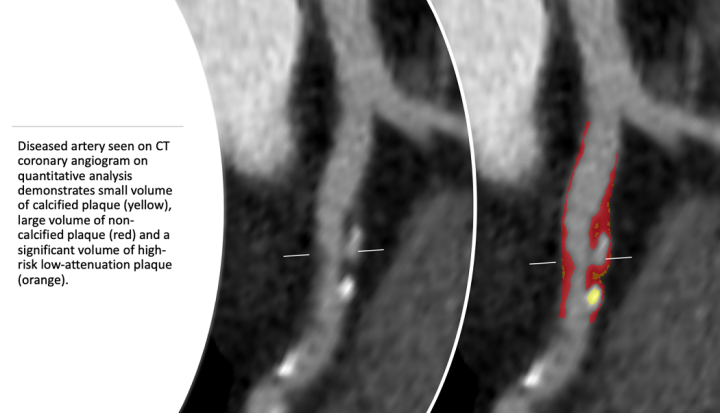12 Oct 21. SCOT-HEART latest findings
The SCOT-HEART team have published their latest findings assessing the association between quantitively assessed measures of plaque burden & five-year clinical outcomes in the SCOT-HEART population.

Traditionally when someone has a CT coronary angiogram, clinicians focus on the severity of stenosis. However, the pathophysiology of cardiovascular events is most often related to the “vulnerability” of a plaque to rupture. Histological plaque characteristics that have been associated with plaque rupture include a thin-fibrous cap & a large lipid-rich necrotic core. On CT coronary angiogram this can be detected as low-attenuation plaque.
A recent paper published in Circulation by Dr Michelle Williams assessed the association between quantitively assessed measures of plaque burden & five-year clinical outcomes in the SCOT-HEART population. Interestingly they found that in these patients who presenting with symptoms of stable coronary disease, the burden of low-attenuation plaque as measured by quantitative analysis was a stronger predictor of future cardiovascular event compared to standard cardiovascular risk scores, coronary artery calcium score & even severity of luminal stenosis. This observation challenges the current clinical paradigm of assessing coronary artery disease & risk of future cardiovascular event & the paper has been cited over 100 times already:
RAPID-CTCA study
A new team are currently working to see if the observations made by Dr Michelle Williams & colleagues in the SCOT-HEART trial of stable patients are applicable in the more acutely chest pain population. As such researchers under the supervision of Professor David Newby & Dr Michelle Williams are undertaking plaque analysis of the RAPID-CTCA trial.
In RAPID-CTCA patients who presented to A&E with acute chest pain were randomised to early CT coronary angiography & standard of care or standard care alone. They found only modest benefit with the routine use of early CT on 1-year outcomes. The team aims to assess whether use of quantitative plaque analysis & in particular the burden of high-risk low-attenuation plaque predicts outcome better in this acute population.
These results are a culmination of collaborative work with the Department of Medical & Biomedical Sciences at Cedars-Sinai Medical Centre in LA who developed the software that allows the team to quantify the burden of plaque subtypes.
Current status of SCOT-HEART 2 study
Following the completion of the SCOT-HEART study, Professor David Newby launched SCOT-HEART 2.
Work is currently underway to recruit for SCOT-HEART 2, which will study the use of CT coronary angiography in patients who have no symptoms of coronary disease.
At present, preventative therapies such as statins are initiated using risk scores based on observational studies. Often the risk threshold is chosen arbitrarily or based on economic determinants. This study hopes to identify whether initiating preventative therapies based on the presence of coronary disease on CT is superior to the current practice of using risk scores.
Social media tags & titles
The SCOT-HEART team have published their latest findings assessing the association between quantitively assessed measures of plaque burden & five-year clinical outcomes in the SCOT-HEART population.
@imagingmedsci @MarcDweck @EdinUniCVS @BHFScotland

